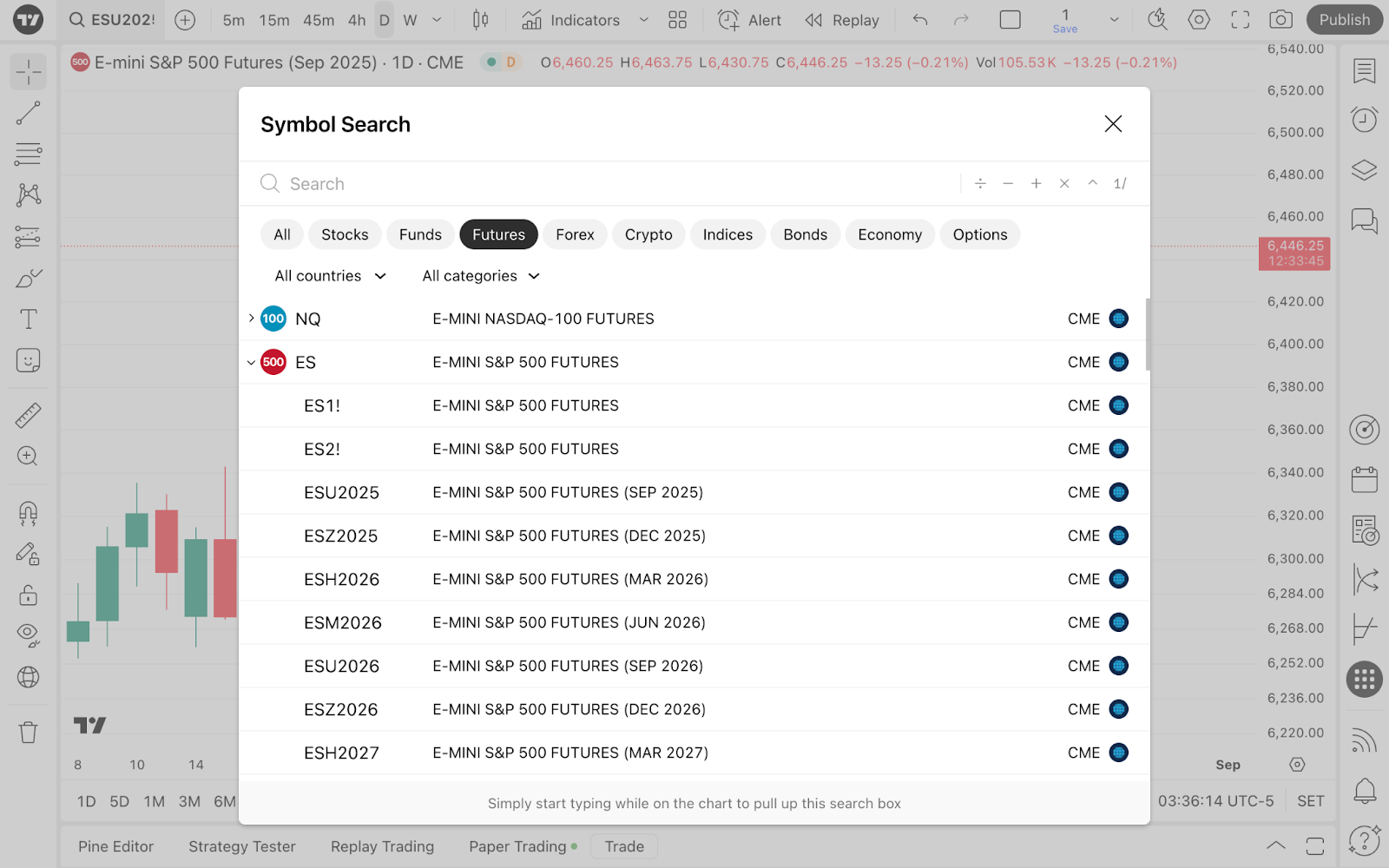Niaga hadapan disimulasikan, pengalaman pasaran sebenar dengan Dagangan Kertas
Dengan Dagangan Kertas, anda boleh berlatih dagangan niaga hadapan tanpa risiko dan membangunkan strategi anda. Sama ada anda pedagang baharu atau berpengalaman, ia boleh membantu anda memahami dengan lebih dalam bagaimana peluputan berfungsi, apakah harga penyelesaian dan bagaimana mekanisma-mekanisma ini berfungsi.
KANDUNGAN:
- Mengapa berlatih dagangan hadapan
- Mula berdagang hadapan
- Aspek-aspek yang perlu diketahui mengenai niaga hadapan dagangan kertas
Mengapa berlatih dagangan hadapan
Niaga hadapan adalah salah satu daripada aset boleh didagangkan paling cair dalam pasaran. Mereka menggabungkan kepelbagaian dengan penyeragaman, membenarkan anda untuk membuat spekulasi mengenai perubahan harga merentasi komoditi, bon, indeks, pasangan forex, mata wang kripto dan hampir semua aset lain yang boleh menjadi asas untuk kontrak niaga hadapan. Sama ada anda mendagangkan bon, komoditi atau hadapan indeks, mereka semuanya beroperasi pada prinsip yang sama.
Persamaan ini bermakna jika anda bergantung kepada analisis teknikal dan memahami asas niaga hadapan, anda boleh bekerja merentasi pelbagai aset dengan efektif.
Akan tetapi, faktor asas juga memainkan peranan penting dalam penentuan harga. Walaupun volum dagangan derivatif selalunya melebihi dagangan semerta (spot), harga hadapan sangat bergantung kepada harga semerta pada aset asasnya. Hubung kait ini bermaksud pergerakan harga boleh dipengaruhi oleh faktor-faktor yang lebih daripada aktiviti dagangan semata-mata.
Sebagai contoh, hadapan komoditi boleh dipengaruhi oleh corak cuaca seperti kemarau yang menyebabkan kekurangan gandum, manakala hadapan Bitcoin bereaksi kepada pemisahan (halving) dan perubahan regulasi. Setiap industri mempunyai pemboleh ubah khusus yang perlu diambil kira oleh pedagang. Pendekatan paling efektif termasuk memahami aset asas anda sepenuhnya, kekal memahami kekangan khusus sektor dan mengikuti berita kewangan semasa untuk kekal termaklum pada perubahan pasaran.
Mula berdagang hadapan
Pertama, sambung kepada akaun Dagangan Kertas anda. Dari Carta Super, cari Panel Dagangan dan pilih Dagangan Kertas.

Kemudian, pilih niaga hadapan yang anda mahu berlatih. Pad bar alat atas di bahagian kiri, cari Carian Simbol. Navigasi ke tab "Niaga Hadapan" untuk mengakses senarai lengkap niaga hadapan yang tersedia. Anda boleh menyusun mereka mengikut negara atau kategori dan terokai opsyen berbeza dengan mengklik anak panah di bahagian kiri logo setiap simbol.

Selain daripada itu, anda boleh menukar simbol carta anda dengan hanya menaip nama — tetingkap carian simbol akan muncul secara automatik.
Aspek-aspek yang perlu diketahui mengenai niaga hadapan dagangan kertas
Walaupun Dagangan Kertas menghampiri simulasi untuk keadaan pasaran sebenar, beberapa daripada ciri-cirinya berbeza daripada dagangan bursa sebenar. Pengubahsuaian ini direka khusus untuk menyelaraskan pengalaman dagangan anda.
Jika anda sudah tahu bagaimana berdagang di TradingView, telah memilih simbol anda, mengkonfigurasikan akaun demonstrasi dan meletakkan dagangan, pertimbangkan sifat niaga hadapan berikut yang boleh memberikan impak kepada hasil dagangan akhir anda.
Pengendalian penyelesaian dan peluputan
- Keuntungan/kerugian direalisasikan anda akan ditunjukkan pada masa penyelesaian
- Posisi anda akan ditutup selepas luput menggunakan harga penyelesaian akhir
- Semua hadapan yang akan luput diselesaikan pada harga penyelesaian akhir
- Harga penyelesaian akhir datang dari bursa
- Jika tidak tersedia, kami menggunakan harga tutup dari bar harian akhir (selalunya dekat dengan harga penyelesaian akhir)
Jenis kontrak dan sokongan akaun
- Hadapan klasik dan kripto disokong dalam semua akaun Dagangan Kertas, termasuk akaun pertandingan di The Leap
- Semua hadapan dianggap sebagai diselesaikan tunai tanpa mengira jenis sebenar mereka, membolehkan anda menguji strategi tanpa sekatan
- Hadapan perpetual dan berterusan tidak mempunyai penyelesaian
Posisi automatik dan pengendalian pesanan
- Sistem akan menutup posisi luput secara automatik
- Platform membatalkan pesanan aktif untuk kontrak yang sudah luput
- Jika anda menentukan komisyen setiap kontrak, ia akan dipotong pada penyelesaian
Pengurus akaun
- Semua pelaksanaan akan dicerminkan dalam tab "Sejarah Akaun" dan "Journal Dagangan"
- Anda boleh menjejak posisi anda, pesanan dan tarikh luput dalam lajur "Tarikh Luput"
Ringkasan
Dengan mendagangkan hadapan kertas, anda boleh membangunkan strategi, memahami mekanik penyelesaian dan menjadi terbiasa dengan kelas aset berbeza sebelum menggunakan modal. Ia memberikan anda pendedahan pasaran yang menghapuskan aspek pengoperasian dalam dagangan hadapan sebenar.
Juga baca: